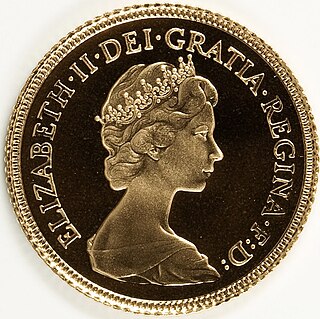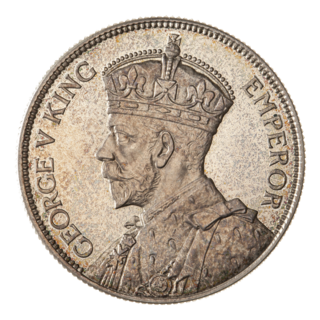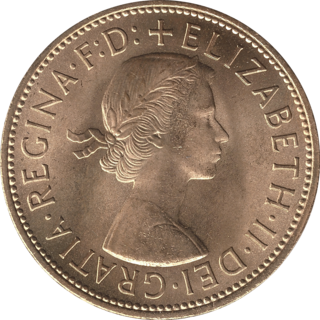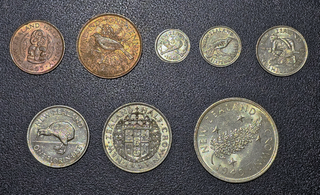
The standard circulating coinage of the United Kingdom, British Crown Dependencies and British Overseas Territories is denominated in pennies and pounds sterling, and ranges in value from one penny sterling to two pounds. Since decimalisation, on 15 February 1971, the pound has been divided into 100 (new) pence. Before decimalisation, twelve pence made a shilling, and twenty shillings made a pound.

The five pound British gold coin, also known as a quintuple sovereign, has a nominal value of five pounds sterling. It has been struck intermittently since 1820, though as a circulation coin only in 1887, 1893 and 1902. Through most of its history, it has depicted, on its reverse, Benedetto Pistrucci's portrayal of St George and the Dragon, which has traditionally been used on the sovereign, or one-pound gold coin.

The British crown was a denomination of sterling coinage worth 1⁄4 of one pound, or 5 shillings, or 60 (old) pence. The crown was first issued during the reign of Edward VI, as part of the coinage of the Kingdom of England.

The half sovereign is a British gold coin denominated at one-half of a pound sterling. First issued in its present form in 1817, it has been struck by the Royal Mint in most years since 1980 as a collector's and bullion piece.
There have been three sets of coins in Ireland since independence. In all three, the coin showed a Celtic harp on the obverse. The pre-decimal coins of the Irish punt had realistic animals on the reverse; the decimal coins retained some of these but featured ornamental birds on the lower denominations; and the euro coins used the common design of the euro currencies. The pre-decimal and original decimal coins were of the same dimensions as the same-denomination British coins, as the Irish punt was in currency union with the British pound sterling. British coins were widely accepted in Ireland, and conversely to a lesser extent. In 1979 Ireland joined the Exchange Rate Mechanism and the Irish punt left parity with sterling; coin designs introduced after this differed between the two countries.
Percy Metcalfe, CVO, RDI, was an English artist, sculptor and designer. He is recognised mostly for his coin designs and his contribution to the Ashtead Pottery Collection.

The pound was the currency of New Zealand from 1933 until 1967, when it was replaced by the New Zealand dollar. Prior to this, New Zealand used the pound sterling since the Treaty of Waitangi in 1840. Like the pound sterling, it was subdivided into 20 shillings each of 12 pence.

The florin is a coin issued for the New Zealand pound from 1933 to 1965, equal to two shillings or twenty-four pence. The coin features a kiwi on the reverse and the reigning monarch on the obverse. It was introduced in 1933 as part of the first issue of New Zealand pound coinage, due to shortages of British silver coins resulting from the devaluation of local currency relative to the pound sterling. A lengthy design process was further protracted due to differing proposed design motifs between the Royal Mint, supporting a reverse design featuring heraldic ships, and the Gordon Coates–appointed Coinage Committee's proposed kiwi design. This disagreement led to almost a dozen proposed designs and revisions before the finalised issue entered circulation in February 1934. Initially struck in silver by the Royal Mint to replace the previous imperial florin, it was struck in cupronickel from 1947 due to rising precious metal prices. While proposed as the base of a decimalised New Zealand coinage since the 1930s, the florin was ultimately replaced in 1967 by the coinage of the New Zealand dollar. Florins remained legal tender with a value of 20 cents until 31 October 2006.

The British shilling, abbreviated "1s" or "1/-", was a unit of currency and a denomination of sterling coinage worth 1⁄20 of one pound, or twelve pence. It was first minted in the reign of Henry VII as the testoon, and became known as the shilling, from the Old English scilling, sometime in the mid-16th century. It circulated until 1990. The word bob was sometimes used for a monetary value of several shillings, e.g. "ten-bob note". Following decimalisation on 15 February 1971 the coin had a value of five new pence, and a new coin of the same value but labelled as "five new pence" or "five pence" was minted with the same size as the shilling until 1990, after which the shilling no longer remained legal tender. It was made from silver from its introduction in or around 1503 until 1946, and thereafter in cupronickel.

The British pre-decimal penny was a denomination of sterling coinage worth 1⁄240 of one pound or 1⁄12 of one shilling. Its symbol was d, from the Roman denarius. It was a continuation of the earlier English penny, and in Scotland it had the same monetary value as one pre-1707 Scottish shilling. The penny was originally minted in silver, but from the late 18th century it was minted in copper, and then after 1860 in bronze.

The double sovereign is a gold coin of the United Kingdom with a face value of two pounds sterling (£2). Rarely issued in the first 150 years after its debut in 1820, it never had a significant presence in circulation. It became a collector and bullion coin, and has been struck most years since 1980. It features the reigning monarch on its obverse and, most often, Benedetto Pistrucci's depiction of Saint George and the Dragon on the reverse.

The halfpenny was first issued in New Zealand in 1940, seven years after the first introduction of a domestic pound coinage. The coin's issuing was scheduled to align with the centennial of the Treaty of Waitangi and the New Zealand centennial, alongside the penny and centennial half-crown. The coin was designed by New Zealand artist Leonard Cornwall Mitchell after winning a government-sponsored design competition, and then modelled by Royal Mint designer Percy Metcalfe. The halfpenny features the head of the reigning monarch on the obverse, with a hei-tiki pendant ornamented and simplified kowhaiwhai woodcarvings on the reverse. The smallest of all denominations of the New Zealand pound, the copper coin was worth 1/480th of a pound, or 1/120th of a crown, the largest coinage denomination. It was discontinued alongside all other New Zealand currency following decimalisation in 1967.

The first coinage of the New Zealand pound was introduced in 1933 in response to large-scale smuggling of prior British imperial coinage after devaluation of New Zealand exchange rates relative to the pound sterling and large influxes of other foreign coinage into circulation. The Coinage Act, 1933 outlined the weights and compositions of various denominations, out of which five silver issues entered circulation over the following year, after lengthy disagreement between rival coinage design committees. The copper penny and halfpenny entered circulation in 1940, corresponding to anniversary of the New Zealand centennial. An eighth denomination of coin, the five-shilling piece or crown, was produced solely through three commemorative issues. The first issue, the Waitangi crown, was produced in extremely limited quantities and sold to collectors. Later commemorative crown issues in 1949 and 1953 were produced for circulation.

The New Zealand penny is a large bronze coin issued from 1939 to 1965. Introduced seven years after the larger denominations of New Zealand pound coinage, the coin's issuing was scheduled to align with the centennial of the Treaty of Waitangi and the New Zealand centennial, alongside the halfpenny and centennial half-crown. Featuring the standard portrait of the ruling monarch on the obverse, the reverse features a tūī bird perched atop a kōwhai branch.

The New Zealand shilling was first issued in 1933 alongside four other denominations of New Zealand pound coinage, introduced due to shortages of comparable British silver coinage following the devaluation of the New Zealand pound relative to the pound sterling. Roughly 24 mm in diameter, it is slightly larger than the British coin it replaced. Worth twelve pence, the denomination was equal to half a florin, two sixpence, or two-fifths of a half-crown.

The New Zealand threepence is a coin of the New Zealand pound issued from 1933 to 1965. Equal to three pence, the coin was the smallest in size of all New Zealand pound coinage and the smallest in denomination of the initial 1933 issue of New Zealand pound coinage, produced due to shortages of British silver coins resulting from the devaluation of local currency relative to the pound sterling. British artist George Kruger Gray designed the coin's reverse design after an earlier pattern design featuring a hei-tiki was rejected by a coinage design committee organised by Gordon Coates. It features two crossed patu below the label "3d". Initially struck in silver by the Royal Mint, it was struck in cupronickel from 1947 onward due to rising precious metal prices. Following decimalisation in 1967, the threepence was replaced by the coinage of the New Zealand dollar.

The New Zealand sixpence is a coin of the New Zealand pound issued from 1933 to 1965. Equal to twice a threepence or half a shilling, the sixpence was one of five denominations of silver coins introduced in the initial issue of New Zealand coinage in 1933. Early designs for the coin featuring spears and silver ferns were rejected by design committees in Britain and New Zealand. The coin's final reverse, designed by George Kruger Gray, features a female huia, an extinct New Zealand bird, perched atop a branch. Issued in 50% silver until a postwar rise in silver prices triggered a shift to cupronickel in 1947, the coin was minted with relative consistency until 1965, when it was discontinued following decimalisation and the adoption of the New Zealand dollar.

The half-crown is the largest of five denominations of New Zealand pound coinage first issued in 1933. Introduced due to shortages of comparable British silver coinage following the devaluation of the New Zealand pound relative to the pound sterling, the coin measures roughly 32 mm (1.3 in) in diameter. It was equal to thirty pence, two and a half shillings, or an eighth of a pound.

The Centennial half-crown is a commemorative coin of the New Zealand half-crown released in 1940 to coincide with the hundredth anniversary of the Treaty of Waitangi. A 1938 government-sponsored design competition for the commemorative half-crown, alongside the concurrently released penny and halfpenny, was won by New Zealand artist Leonard Cornwall Mitchell. The coin features a Māori woman surrounded by traditional Māori architecture on her right, a modern cityscape on her left, and a rising sun behind her head. The coin, like other contemporary New Zealand half-crowns, had a diameter of 32 mm and a weight of 14.14 grams, and was struck by the Royal Mint in .500 fineness silver. Unlike the Waitangi crown, the first New Zealand commemorative issue, a large mintage of 100,800 coins was produced and released directly into circulation at face value. However, the popularity of the coin led to it rapidly exiting circulation into private collections.

A commemorative crown coin of the New Zealand pound was produced for a planned visit by King George VI in 1949. Having first visited the country in 1927 in his duties as the Duke of York, proposals for a visit by the monarch to New Zealand in 1940 were postponed by the outbreak of World War II. A 1949 tour by the king and queen to Australia and New Zealand was announced in early 1948, the first visit of a reigning monarch to the dominion.























